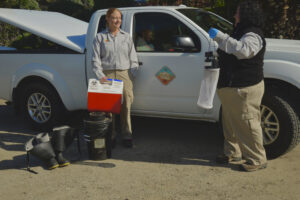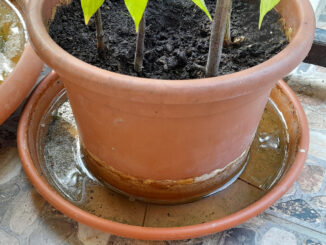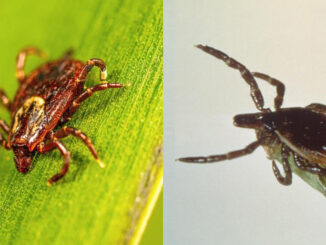
Science-based mosquito control strategies in Santa Barbara County challenge long-held public misconceptions and highlight how residents can help
by Elizabeth Ann Morabito
Did you know people once believed mosquitoes were created from mud?
In the 1600s, many thought these pests spontaneously appeared from damp earth—a belief that held for centuries before science uncovered the truth. While we’ve long since moved on from that myth, misconceptions about mosquitoes—and how to control them—still persist today.
So what’s fact, and what’s fiction? Let’s set the record straight.
We don’t do any adulticiding. Other districts do, but we carefully inspect standing water and if there’s larvae present, then we treat.
Karen Schultz, vector control technician at MVMD
Myth: Mosquito control is all about killing adults.
Fact: The real fight happens before mosquitoes can even bite. The Mosquito and Vector Management District (MVMD) focuses daily efforts on stopping mosquitoes in their larval stage. By targeting breeding grounds through larvicides that kill mosquito larvae, biological controls, and habitat reduction, they prevent mosquitoes from ever growing into biting adults. It’s a smarter, safer, and more effective way to reduce populations.
“We don’t do any treatments that target adult mosquitoes called adulticiding,” clarifies Karen Schultz, vector biologist technician at MVMD. “Other districts do, but we carefully inspect standing water and if there’s larvae present, then we treat.”
Myth: MVMD uses widespread spraying to control mosquitoes.
Fact: MVMD does not use fogging or aerial sprays for routine mosquito control. Instead, they rely on targeted, dry treatments like granules and briquettes, applied directly to mosquito breeding sites. These methods stop larvae before they become adult mosquitoes—avoiding unnecessary chemical exposure or environmental drift.
Myth: Mosquito control harms the environment, pets, or wildlife.
Fact: MVMD uses EPA-approved larvicides that specifically target mosquito larvae. These treatments are harmless to drinking water, fish, pets, and beneficial insects when applied according to label directions. These treatments often contain a common bacterium found in nature that’s deadly to mosquito larvae but safe for everything else.
“Even if butterflies or bees drink the water, it won’t harm them,” Schultz notes.
In rare cases where mosquito populations become unmanageable, MVMD may also use ultra-low-volume, EPA-approved sprays in controlled doses. These are carefully formulated to target only mosquitoes, minimizing risk to people, pets, and pollinators.
MVMD also offers mosquito fish—a natural and effective alternative to larvicides for controlling mosquito populations. The predators feed on mosquito larvae and thrive in ponds, fountains, and livestock troughs.
Myth: All mosquitoes bite at night.
Fact: Some invasive species, like Aedes aegypti, bite aggressively during the day. Known as “ankle biters,” these mosquitoes can transmit serious illnesses and should be reported immediately if you think you’ve spotted them.
Myth: There aren’t any mosquitoes in the winter.
Fact: Due to weather conditions ideal for breeding, mosquitoes in Santa Barbara County are present year-round. While populations spike in warmer months, MVMD continues to trap and track mosquitoes even in cooler seasons to prevent outbreaks since a few local species are adapted for cold weather. Also, climate change has expanded and intensified breeding seasons, creating ideal conditions for certain species to persist longer than ever.
Myth: If you don’t see standing water, there’s no mosquito risk.
Fact: Mosquitoes can breed in surprisingly small amounts of water. Even a bottle cap full is enough for some species like Aedes aegypti.

information about mosquitoes and the District’s
mosquito control efforts
Photo credit Nell Campbell
Myth: Mosquito traps are used to reduce mosquito populations.
Fact: MVMD’s traps are tools for monitoring, not controlling, mosquito populations. Mosquitoes caught in traps are inspected and tested for harmful viruses. This process determines species present, measures population size, and identifies any diseases being carried, which in turn guides treatment plans.
“We place traps near areas we know will produce mosquitoes,” explains Schultz. “For example, if we’re treating a large marsh, we might set a trap to monitor what percentage of the mosquitoes we were able to eliminate.”
Myth: Mosquitoes are just a nuisance—they don’t spread disease locally.
Fact: Unfortunately, certain species can spread disease. West Nile Virus is one of the most pervasive mosquito-related threats in California. Invasive species like Aedes aegypti can also carry dengue, Zika, and Chikungunya viruses—and their reach is expanding.
How you can help keep Santa Barbara County safe:
- Spot unusual mosquito activity? Especially daytime ankle biters? It could be invasive Aedes aegypti—report immediately: mvmdistrict.org/contact-us or call (805) 969-5050.
- See standing water or a neglected pool? Let MVMD know: mvmdistrict.org/contact-us or call (805) 969-5050.
- Found a dead bird? It may be linked to West Nile Virus. Report it to the California Department of Public Health: westnile.ca.gov/report.



